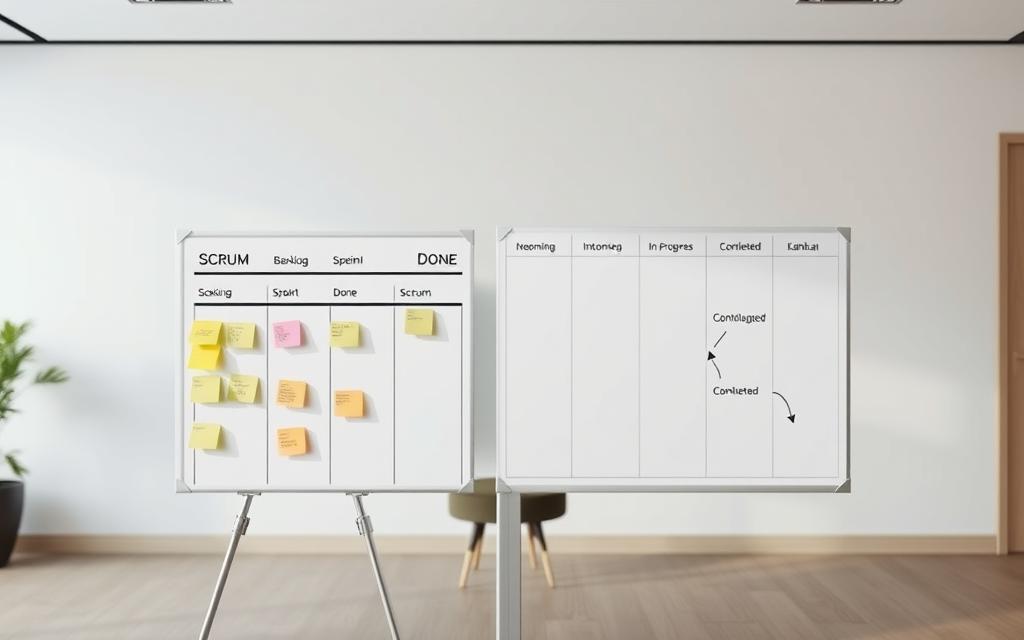Modern teams need flexible workflows to thrive in fast-paced environments. This approach, rooted in Toyota’s lean manufacturing principles, prioritizes adaptability over rigid planning. By breaking tasks into smaller cycles, teams can deliver value faster while staying aligned with shifting priorities.
Traditional methods like the waterfall model often struggled with changing requirements. In 2001, a group of software experts introduced a better way: iterative methods focused on collaboration and incremental progress.
These practices revolutionized how teams build products, emphasizing transparency through tools like the kanban board and regular feedback loops.
The impact extends beyond tech industries. From its origins in auto manufacturing to today’s software development breakthroughs, this philosophy empowers teams to pivot quickly. Daily stand-ups and sprint reviews keep everyone informed, creating a culture where adjustments happen smoothly.
This guide explores proven strategies to implement these dynamic practices effectively. You’ll learn how to foster teamwork, streamline processes, and maintain momentum—even when challenges arise. Let’s dive into the techniques that help organizations turn uncertainty into opportunity.
Introduction to Agile Project Management

Shifting priorities demand frameworks built for rapid response and continuous improvement. These strategies, rooted in collaborative principles, prioritize people over processes and deliver tangible results through incremental progress.
Understanding the Agile Manifesto
In 2001, seventeen software pioneers established four core values to guide teams through complexity. First, they emphasized individuals and interactions over rigid tools. Second, working solutions became more valuable than exhaustive documentation.
Third, customer partnerships took priority over contract negotiations. Finally, embracing change became crucial over following strict plans. This mindset shift allowed teams to pivot quickly without losing momentum.
Key Benefits of the Agile Approach
Teams adopting these practices see measurable improvements. Productivity spikes because focused sprints prevent scope creep. Collaboration strengthens when roles like the scrum master facilitate clear communication.
Regular feedback loops also reduce risks, allowing adjustments before issues escalate. Customers receive updates faster, building trust through visible progress. By empowering cross-functional teams to self-organize, delays shrink.
The scrum master ensures alignment while removing obstacles, creating a rhythm where quality and speed coexist. This approach turns unpredictability into a strategic advantage.
Overview of Agile Methodologies: Scrum and Kanban
Teams tackling complex work often choose between two popular frameworks to streamline their processes. Each method offers unique advantages for organizing tasks, improving collaboration, and delivering results. Let’s explore how these systems help teams adapt to changing priorities while maintaining momentum.

Scrum Framework Explained
Scrum structures work into fixed-length cycles called sprints, typically lasting 2-4 weeks. During sprint planning, teams select tasks from a prioritized backlog and define clear goals. Daily stand-up meetings keep everyone aligned, while sprint reviews showcase completed work to stakeholders.
Roles like the scrum master and product owner ensure accountability. The scrum master removes obstacles, while the product owner refines requirements based on feedback. This approach works well for development teams tackling projects with evolving specifications.
Kanban Framework Explained
Kanban focuses on continuous flow rather than fixed iterations. Teams visualize tasks on a board with columns like “To Do,” “In Progress,” and “Done.” Work-in-progress (WIP) limits prevent overload by casing how many tasks can move through each stage simultaneously.
This method suits teams handling ongoing maintenance or unpredictable workloads. Product managers benefit from real-time visibility into bottlenecks, allowing swift adjustments. Unlike scrum’s structured ceremonies, kanban emphasizes gradual improvements through metrics like cycle time.
For a detailed comparison of Scrum and Kanban, explore how each framework supports different team dynamics and product goals.
Essential Tools and Techniques for Agile Projects
Visual clarity drives team success in dynamic environments. By mapping workflows onto physical or digital boards, groups spot inefficiencies and celebrate wins collectively. These tools transform abstract goals into actionable steps everyone understands.

Utilizing Scrum Boards and Kanban Lanes
Scrum boards break work into sprint-specific columns like “To Do,” “In Progress,” and “Done.” Teams update tasks daily, creating momentum through visible progress. This framework ensures alignment with quarterly business objectives during planning sessions.
Kanban lanes focus on continuous delivery. Limiting work-in-progress items prevents overload, while color-coded cards highlight priority tasks. Real-time updates let managers adjust timelines before delays impact client commitments.
Both systems rely on three principles:
- Transparency: Every task’s status is public
- Feedback loops: Daily check-ins refine priorities
- Adaptability: Teams pivot without derailing workflows
To maximize results, start with simple boards and add complexity gradually. Review layouts weekly to match shifting business needs. When teams see their contributions moving toward goals, engagement and output soar.
Mastering Agile Workflows: Sprints, Backlogs, and Ceremonies
Structured rhythms keep teams focused in fast-moving environments. By organizing tasks into timed cycles and refining priorities through key meetings, groups maintain momentum while adapting to new requirements. Let’s explore how these practices turn chaos into coordinated action.

Sprint Planning and Execution
Effective cycles start with clear goals. Teams review backlogs to select high-impact tasks, estimating effort and aligning with stakeholder needs. A well-defined sprint goal acts as a compass, guiding decisions when unexpected change occurs.
Daily check-ins ensure progress stays visible. Members share updates in 15-minute standups, highlighting blockers and adjusting workloads. This rhythm builds accountability without micromanagement.
Daily Standups and Retrospectives
Regular feedback sessions fuel growth. After each cycle, teams analyze what worked and identify improvements. Retrospectives turn insights into action items for the next sprint, creating a culture of continuous learning.
Three elements make ceremonies impactful:
- Clear agendas to keep discussions focused
- Timeboxing to prevent meetings from dragging
- Visual tools like digital boards to track commitments
By balancing structure with flexibility, teams deliver consistent value. Open collaboration ensures everyone’s voice shapes outcomes, transforming individual efforts into shared success.
agile project management: Strategies for Software Development
Software teams thrive when they can adapt quickly to market shifts. By using iterative cycles and prioritizing customer feedback, groups deliver value faster while reducing wasted effort. One fintech company cut release times by 40% after adopting two-week sprints, proving how responsive workflows drive results.
Effective teams track progress through visual tools like digital boards. Color-coded columns show task statuses, while WIP limits prevent overload. Daily check-ins help identify blockers early, keeping timelines on track without micromanagement.
Iterative reviews set this approach apart from outdated models. After each cycle, teams demo features to stakeholders and refine priorities. This flexible process lets developers adjust code based on real user needs instead of rigid specs.
Key strategies for success include:
- Breaking features into smaller, testable components
- Automating deployments to accelerate feedback loops
- Using retro meetings to celebrate wins and address hurdles
A SaaS startup used these tactics to reduce bugs by 60% in six months. Their board became a collaboration hub, showing how tasks aligned with quarterly goals. By focusing on incremental value, they outpaced competitors clinging to annual release plans.
Building and Leading a Collaborative Agile Team
Successful teams thrive when every member understands their role. Clear responsibilities prevent confusion and keep sprints on track. Let’s explore how defining positions and nurturing open dialogue create environments where innovation flourishes.

Defining Roles: Scrum Master, Product Owner, and Team Members
The scrum master acts as a guide, removing roadblocks so developers can focus. They ensure meetings stay productive and help teams stick to time limits. Product owners prioritize tasks based on client needs, bridging gaps between stakeholders and coders.
Developers and testers handle execution, breaking complex goals into manageable steps. When everyone owns their part, changes get addressed faster. This structure aligns with the agile manifesto by valuing individuals over rigid processes.
Fostering Effective Communication
Daily check-ins keep conversations focused. Teams share progress in 15-minute standups, highlighting wins and hurdles. Visual boards display task statuses, making it easy to spot delays before they derail sprints.
Three practices strengthen teamwork:
- Rotating facilitation duties to build leadership skills
- Using retrospectives to refine meeting formats
- Setting clear response time expectations for emails
Leaders who listen first create spaces where ideas flow freely. By modeling accountability and celebrating small wins, they turn groups into cohesive units ready for any challenge.
Leveraging Agile Techniques for Business Growth and Adaptability

Market shifts now demand frameworks that turn uncertainty into strategic fuel. By reshaping the development process, companies gain flexibility to pivot faster than competitors. Teams using iterative methods reduce time-to-market by 30-50% compared to traditional models, according to a global retail case study.
Continuous improvement thrives when development teams break projects into smaller cycles. Weekly reviews allow quick adjustments based on customer behavior or supply chain changes. This iterative approach helps businesses test ideas cheaply before scaling successful concepts.
Three key practices align workflows with growth goals:
- Mapping software updates to quarterly revenue targets
- Training cross-functional teams to handle shifting priorities
- Using real-time dashboards to track market response
A fintech startup doubled user retention by aligning their development process with customer feedback loops. Their team released biweekly updates addressing pain points revealed through app analytics. This responsiveness helped them outpace slower-moving rivals.
Adaptable frameworks also future-proof operations. When supply chain disruptions hit, manufacturers using visual task boards reallocated resources within days. Their development teams redesigned workflows to prioritize critical shipments, maintaining 95% on-time delivery rates.
By treating change as data rather than disruption, businesses build resilience. Regular retrospectives turn challenges into refined strategies, ensuring software and services evolve alongside customer expectations.
Incorporating Customer Feedback and Continuous Improvement
Customer insights fuel smarter decisions in evolving markets. Teams that prioritize listening build products people love while staying ahead of trends. Regular check-ins with users transform raw data into actionable steps, creating a cycle where every update delivers clearer value.
Implementing Iterative Reviews
Weekly demo sessions let customers shape outcomes early. A fintech team reduced app errors by 35% after showing prototypes during development. These reviews focus on three goals:
- Validating features against real-world needs
- Identifying minor issues before launch
- Aligning updates with business objectives
Teams using this methodology adapt faster because feedback arrives in digestible chunks. Instead of waiting months for results, they make course corrections every 7-14 days.
Refining Processes Based on Real-Time Feedback
Live dashboards track user behavior to guide priorities. When an e-commerce platform noticed checkout drop-offs, they redesigned the flow within one sprint. This approach aligns with core principles:
Transparency: Shared metrics keep everyone focused on customer goals. Flexibility: Teams adjust task sequences without bureaucratic delays. Ownership: Developers propose solutions during retrospectives.
One SaaS company boosted retention by 22% after implementing daily feedback summaries. Their process now includes quick polls after feature releases, turning user opinions into next-week improvements.
Tips for Overcoming Common Agile Challenges
Navigating rapid changes requires smart tactics to keep teams on track. Common hurdles like shifting priorities and resistance to new methods can slow progress. Let’s explore practical ways to maintain momentum while adapting to evolving needs.
Managing Change and Shifting Priorities
Start by refining your sprint planning process. Break large goals into smaller tasks that fit within 1-2 week cycles. This makes unexpected changes easier to handle without derailing entire workflows.
Visual tools like kanban boards help teams spot bottlenecks early. Limit work-in-progress items to prevent overload and keep focus on high-impact tasks. Regularly review your backlog to reprioritize based on new information.
Three strategies ensure smooth adjustments:
- Host quick daily check-ins to address blockers
- Use retrospectives to improve processes
- Celebrate small wins to boost morale
These practices deliver clear benefits: faster response times, better alignment with goals, and stronger team confidence. When changes feel manageable rather than disruptive, groups adapt faster and produce better results.
Conclusion
Successful implementation of dynamic workflows hinges on mastering core principles. Clear roles—like scrum masters and product owners—create accountability, while visual boards ensure transparent delivery. These practices turn shifting priorities into organized action.
Traditional and modern approaches thrive when teams adapt them to their environment. Whether using sprints or continuous flow, the guide’s strategies help balance structure with flexibility. Regular retrospectives and feedback loops keep improvements ongoing.
At its heart, this philosophy centers on values like collaboration and adaptability. By breaking big goals into smaller wins, teams build momentum and reduce risks. Metrics become tools for growth rather than just checkboxes.
Ready to elevate your workflows? Use these insights to refine roles, streamline delivery, and foster a culture where every challenge sparks innovation. Start small, iterate often, and watch your efforts drive measurable results.
